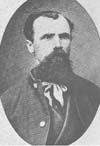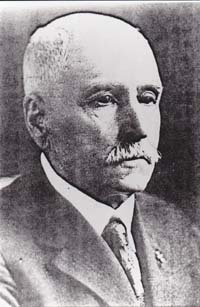 Frederick William Benteen (left) married Catherine Louise Norman on January 7, 1862. He was Captain of Company H and commanded a battalion during the Battle of the Little Bighorn. He performed scouting duty and participated in the hilltop fight, during which he was wounded.
Frederick William Benteen (left) married Catherine Louise Norman on January 7, 1862. He was Captain of Company H and commanded a battalion during the Battle of the Little Bighorn. He performed scouting duty and participated in the hilltop fight, during which he was wounded.
George Blunt was born on January 9, 1846, in Baltimore, Maryland. He was a Private in Company K who participated in the hilltop fight.
Francis Johnson Kennedy died on January 9, 1924, in St. Paul, Minnesota. His obituary claimed he was prevented from participating in the battle because of a snake bite. That contradicts all other accounts that have him in sick quarters prior to the battle, with the pack train in June, and fighting on Reno Hill during the battle. At some point, Kennedy apparently said he led Capt. Keogh’s horse Comanche. If his obituary is to be believed, he was perhaps the only “Reverse Sole Survivor;” i.e., someone who was at the battle but claimed not to have been.
 John W. Burkman (left) was born in Allegheny County, Pennsylvania, on January 10, 1839. He was a Private with Company L who was with the pack train and participated in the hilltop fight.
John W. Burkman (left) was born in Allegheny County, Pennsylvania, on January 10, 1839. He was a Private with Company L who was with the pack train and participated in the hilltop fight.
John Dolan (right) married Lena C. Eagan on January 10, 1876. His second marriage to Josephine Fisher was in 1900. He was a Private in Company M who was on detached service during the battle.
Ferdinand A. Culbertson died on January 10, 1889, in Detroit, Michigan, and was buried in the Woodmere Cemetery there. He was a Sergeant in Company A who participated in the valley and hilltop fights.
Timothy Sullivan died on January 10, 1903, in Washington, D.C., and was buried in the Soldiers’ Home National Cemetery there. He was a Private with Company L who was with the pack train and in the hilltop fight.
Benjamin Franklin Burdick died on January 11, 1930, in Albany, New York, and was buried in the Beverwyck Cemetery in Rensselaer, New York. He was a Private in Company A who was not present at the battle due to detached service.
Bernard Lyons died on January 12, 1901, in Chicago, Illinois, and was buried in Calvary Cemetery in Evanston, Cook County, Illinois. He was a Private with Company F who was in the hilltop fight.
John H. Jordan died in Hartford, Connecticut, on January 12, 1906, and was buried in Old North Cemetery there. He was a Private with Company C who was with the pack train and participated in the hilltop fight.
Lawrence Murphy died on January 13, 1888, at the Soldiers’ Home in Washington, D.C. He was a Sergeant with Company E, but he was on detached service during the battle.
William Martin died in Knoxville, Tennessee, on January 13, 1900, and was buried there. He was a Private with Company B who participated in the hilltop fight.




